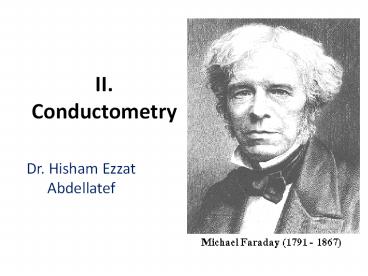II. Conductometry PowerPoint PPT Presentation
1 / 21
Title: II. Conductometry
1
II. Conductometry
I V / R
- Dr. Hisham Ezzat Abdellatef
2
Introduction
- Conductance is the ability of the medium to
carry the electric current. - migration of positively charged species towards
the cathode and negatively charged ones through
the anode
ohm-1(seimen)
E is the potential difference, i is the
current intensity.
From Ohm low
3
The conductance of the solution depends on
- 1. Temperature
- It is increased by increase of temperature.
- 2. Nature of ions
- size, molecular weight, number of charges the ion
carries and other factors - 3. The concentration of ions
- As the number of ions increases the conductance
of the solution increases. - 4. The size of the electrodes
L/A is cell constant K is the specific
conductance or conductivity ohm-1cm-1 or
seimen/cm.
4
- Equivalent conductance ?
- It is defined as the conductance of one gram
equivalent of solute contained between electrodes
spaced one centimeter apart. - Where C is the concentration in gram equivalent
per liter. - Equivalent ionic conductance
- At infinite dilution, interactions become nil
- the overall conductance of the solution consists
- of the sum of the individual equivalent ionic
- conductance
- ?o ?o ?-o
5
Instrumentments
- Two parts
- conductivity bridge.
- Conductance cell
6
(No Transcript)
7
(No Transcript)
8
(No Transcript)
9
(No Transcript)
10
(No Transcript)
11
(No Transcript)
12
Application of conductivity
- Direct or absolute measurments
- checking purity of distilled water or other
chemicals. - determination of physical constants such as
- ionization constant.
2. Conductometric titrations
- Very dilute solutions.
- Turbid and highly coloured solutions.
- Reaction which is not complete and where there is
no suitable indicator, - e.g. reaction between weak acid
and weak base.
13
(No Transcript)
14
(No Transcript)
15
(No Transcript)
16
- 1. Titration of strong acid with strong base
- The reaction is represented by the following
equations - e.g. H Cl- Na OH- ? H2O Na
Cl-
17
- 2. Very weak acid with strong base or a very weak
base with stronger acids
18
- Determination of mixture of hydrochloric acid
(strong acid) and acetic acid (weak acid) with
sodium hydroxide (strong base)
19
- 3. Precipitation and complex formation reaction
- Na Cl- Ag NO3- ? AgCl Na
NO3-
20
- Conductivity as a function of the volume of added
standard solution in the titration of an
approximately 0.1 molar acetic acid solution (V
5 ml) with a sodium hydroxide solution (c 0.1
mol l-1)
21
(No Transcript)

